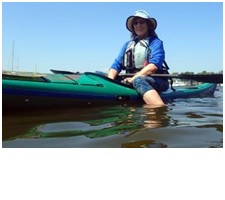By Paula Hubbard
CPA Winter Events—CPA traditionally holds several indoor events where we can get together and talk about our favorite activity, kayaking, while learning some new things. Navigation class was held at the end of February, and the Cold Water Clinic was held on March 9th. The first part of the Cold Water Clinic was a presentation by Jim Zawlocki. He discussed the dangers of cold water and what happens when someone is suddenly immersed in cold water. Next, he went through cold water gear and how we mitigate the risks involved with cold water immersion. Finally, the participants had a chance to test their gear in 42 degree water. The results of the test were mixed. Many leaks were discovered. This is why you always want to test your gear in a controlled environment before you need it to save your life.
This article will summarize the information we provided in the Cold Water Clinic using the material provided by Jim as well as information from the National Center for Cold Water Safety.
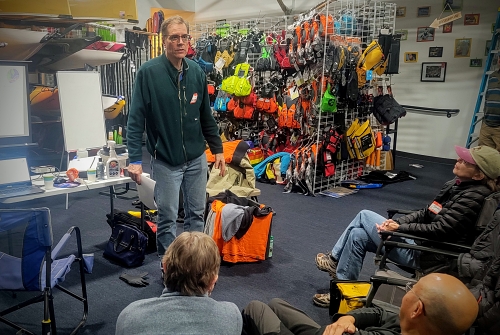
When is the Water Considered Cold?—If you were to swim without any protective gear, the water would feel cold when you first entered at about 65 to 70 degrees. But people swim in lakes, ponds, and the ocean all the time. The physical activity of swimming can make you feel warm enough, but if that activity stops, or you are immersed for a long period of time, you will eventually feel cold and may become hypothermic. While you may feel comfortable in light weight clothing at 70 degrees, water will be profoundly different. Water has a much higher thermal transfer coefficient than air. The thermal transfer coefficient represents how effectively heat is transferred between a surface and its surroundings. Water conducts heat more readily than air, and water can absorb and store more heat than air.
Once the water temperatures are below 60 degrees, the water is cold enough to induce cold shock, and below 50 degrees, it may actually feel painful when you are suddenly immersed.
The Dangers of Cold Water
Sudden Drowning and Cold Shock—Sudden immersion in water less than 60 degrees without protective cold water gear causes a loss of breathing control and a gasping response and hyperventilation that can lead to inhalation of water and drowning. There is also an increase in heart rate and blood pressure due to contraction of blood vessels at the body’s surface in response to the cold. This may lead to heart failure or stroke in susceptible people. Finally, the sudden exposure to cold water causes mental incapacitation, disorientation, panic, etc. All of this may happen within the first 3 to 5 minutes of falling into cold water.
Incapacitation—If cold shock doesn’t kill you, the next threat is loss of physical dexterity. Your muscles and nerves simply stop functioning. Without protective gear, your fingers and hands may simply stop working, so imagine using a paddle float for reentry, putting on a spray skirt or using a phone or VHF radio. These tasks may become impossible. Swimming failure can occur, even in very strong swimmers. There have been documented cases where military personnel have been immersed in cold water and were unable to swim 50 yards to shore. Once incapacitated, there is a decreased ability to keep your head above the waves and the risk of drowning is increased.
Hypothermia—Now that you have survived the initial cold shock and incapacitation, there is still a risk of hypothermia. This can even happen if you are back in your boat and paddling. Hypothermia is classified as mild, moderate, or severe.
Mild Hypothermia occurs when a paddler becomes significantly chilled. There is shivering, mental confusion, some loss of manual dexterity. It’s important to recognize the signs of mild hypothermia in members of the group because the paddler may not be aware that they are becoming hypothermic. Treatment for mild cases includes voluntary physical activity such as paddling, warm dry clothing, warm drinks avoiding caffeine and alcohol, high calorie food. Awareness and treatment of mild hypothermia will prevent the paddler from deteriorating into more severs stages.
Moderate Hypothermia is a medical emergency. This is when the core body temperature starts to drop and the person will need medical attention. In this case the heart rate begins to drop and the peripheral pulse may be difficult to feel. Continue to try to keep the person warm until medical help arrives.
Severe Hypothermia is the continued decrease in body temperature below 95 degrees. The person may lose consciousness. Treatment requires medical professionals and care must be taken when moving the person and warming must be controlled.
Cold Water Gear—Cold water gear is a collection of protective clothing that is worn to provide protection and prevent cold shock, incapacitation, and hypothermia. The type of clothing and equipment depends on the environment including wind and air temperatures, and the actual water temperatures. Waters higher density contributes to this. Essentially, cold water can suck the heat out of you.
Simply covering the skin will help prevent the initial cold water shock that is caused by the reaction of skin to the direct effects of cold water. Adding insulation reduces the rapid loss of heat and extends the time before you are incapacitated or become hypothermic.
The 120 “Rule”—This is not an actual rule, although some still talk about it. This rule says that when the water plus the air temperature is above 120 degrees, you don’t need cold water gear. There is no scientific basis to this rule and common sense indicates that if the water temperature is 60 degrees (cold) and the air temperature is 60 degrees (cool), you would not be happy falling into the water. It’s better to look at each situation and make a determination based on environment, wind, waves, air temperature, water temperature, etc.
Types of Cold Water Gear
Wet Suits—A wet suit works by trapping a layer of water inside the neoprene. This water is warmed by your body heat and prevents additional cold water from entering. The insulating capabilities of a wet suit depends on the thickness of the neoprene. If a wetsuit is too loose, it allows additional cold water to flush through and defeats the purpose. Thick wet suits can be restrictive so many people chose the Farmer John or Farmer Jane versions. These are sleeveless wet suits that provide insulation for your core, but your arms and shoulders are exposed. Combining this type of wet suit with a fleece top and dry top or a neoprene or Hydroskin jacket works well for many paddlers.
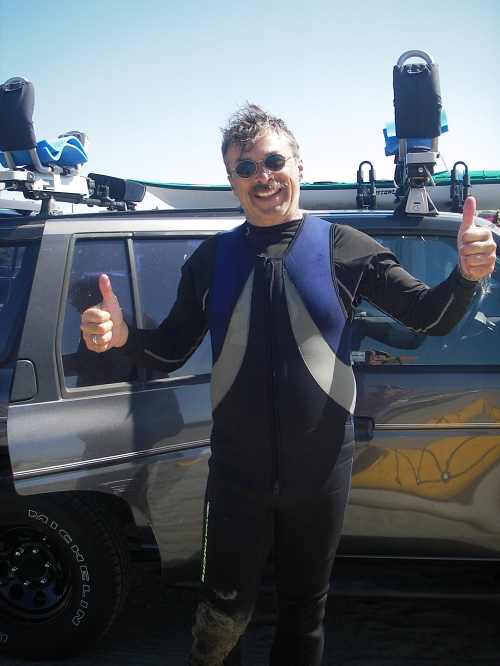
Hydroskins—Hydroskins, made by NRS have a neoprene base with a nylon – spandex outer layer and a plush inner lining. These are frequently lighter than a wet suit and allow more freedom of movement. The insulation capacity depends on the thickness of the material, and come in 0.5, 1.0, and 1.5 mm options.
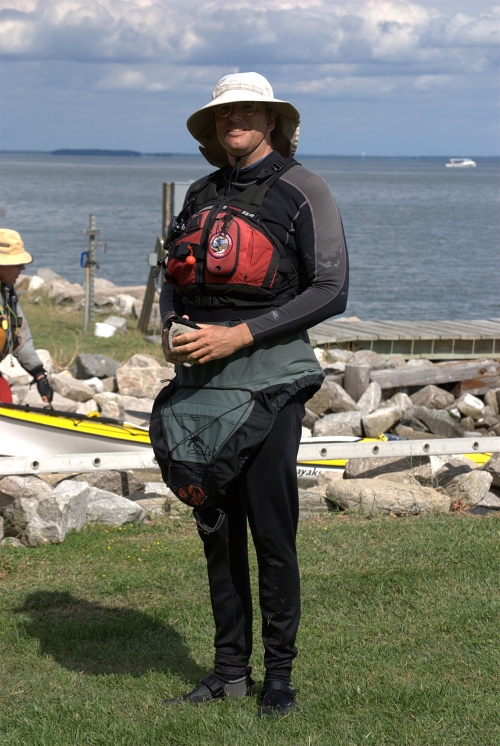
Dry Suits—Dry suits are designed to keep water from coming in, therefore keeping you dry. Alone the dry suit is simply a waterproof shell that provides little to no insulation. Insulation is provided by the layers worn under the dry suit that traps the air inside. The thicker the layer of air, the more warmth. Dry suits can be used at many different water temperatures because you control the amount of insulation and layers that you wear.
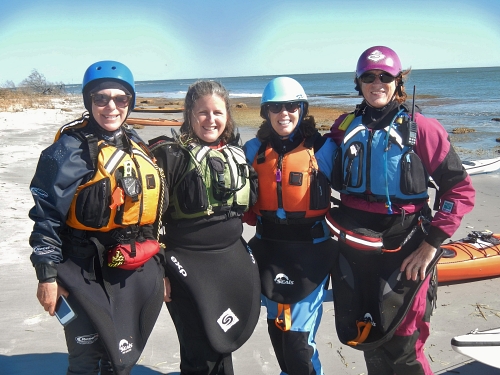
When you first get into the dry suit, you will find that there is a lot of air trapped and this can restrict your ability to move freely. Removing the excess air, called burping the suit will make it more comfortable. You can remove too much air, so that you look as if the suit was shrink wrapped. This may compress the insulation layers and make the suit ineffective.
Head Protection—Hats and wool caps are fine for keeping your head warm in cool to moderately cold water (above 55 degrees F is my general point of reference) but Neoprene hoods or balaclavas are the best for very cold water. Look for something that will stay on in the event of a capsize, and something that covers the ears. Many paddlers experience vertigo when cold water gets into the ears. Even with a strong roll, this can interfere with your ability to right yourself. In addition to the neoprene cap, earplugs can be used.
Hand Protection—Incapacitation will affect your hands, even in a dry suit. If your hands go numb, you can’t get back into your boat, put on your spray skirt, or use a phone or radio to call for help. Neoprene gloves are the best protection. Maintaining circulation to your hands is critical. First, if your core insulation is inadequate, the body will compensate by reducing blood flow to your extremities, making them feel colder. Second, wearing gloves that are too tight will also reduce circulation making it hard to keep your hands warm.
Pogies or Mittens may be excellent at keeping your hands warm while paddling, but can be useless if you capsize. I discovered that I couldn’t roll when my hands were inside pogies that were attached to the paddle. To perform a rescue, you will need to take your hands out of the pogies or mittens. Unless you have a glove on under, your hands will be completely exposed to the cold.
Feet—Neoprene boots are again the best method for protecting your feet. Most dry suits have built in socks that keep water from coming in, but provide no insulation. Wearing an insulating layer under the dry suit sock is important in keeping your feet warm. Neoprene boots over the dry suit socks both protect the dry suit material and provide additional insulation. Make sure that the boots are not too tight, otherwise they will compromise circulation leading to cold feet.
Paddle Jackets, Dry Tops, Storm Cags—Sometimes it is helpful to add a layer on top of your base cold weather gear. Once you are wet, cold air temperatures and wind can cause convection cooling even though you are not in the water. Paddle jackets or splash jackets can be used as wind breakers, but unless there are gaskets at the wrists and neck, they will fill with water if you wind up swimming.
Dry tops have neck and wrist gaskets similar to a dry suit. They are snug around the waist and will minimize the amount of water that gets in if you swim. These also act as a wind breaker, and the trapped layer of air inside provides some additional insulation. But if you swim, these are not actually dry. Both Splash tops and dry tops typically are worn under your PFD.
Storm Cags can be worn on top of all of your gear including your PFD. These can be worn as an additional layer while taking a lunch break on a cold windy beach or in the event of a summer storm when the temperature drops significantly during a cold rain event.
Swim Testing—The CPA Cold Water Clinic ended with a swim test. Our paddlers put on their insulation layers, added the dry suits, neoprene caps and hoods, gloves, boots…and lowered themselves into the water. Swim Testing tells us a lot about our gear.

• Is the insulation adequate for the water temperature, 42 degrees at the time of the test?
• Are the gaskets leaking?
• Are the zippers leaking?
• Did you get enough air or too much air out of your dry suit when you burped it?
• Do the gloves keep your hands warm?
• What happens when you put your face in the water?
If you don’t want to swim test the gear, what about when you unexpectedly fall in. That’s not the best time to find out that there is a problem.
Summary—Thanks again to Jim Zawlocki for leading the Cold Water Clinic. CPA needs volunteers to lead this type of event. Share your knowledge and if you volunteer, there will be lots of people to support you. Material for this article came from Jim’s presentation and from the National Center for Cold Water Safety. This center was started by former CPA member Moulton Avery, who now lives on the Oregon Coast. His web site contains additional information plus case studies of what happens when things go wrong in cold water.
Happy Paddling and stay warm.
Paula Hubbard CPA Coordinator.
